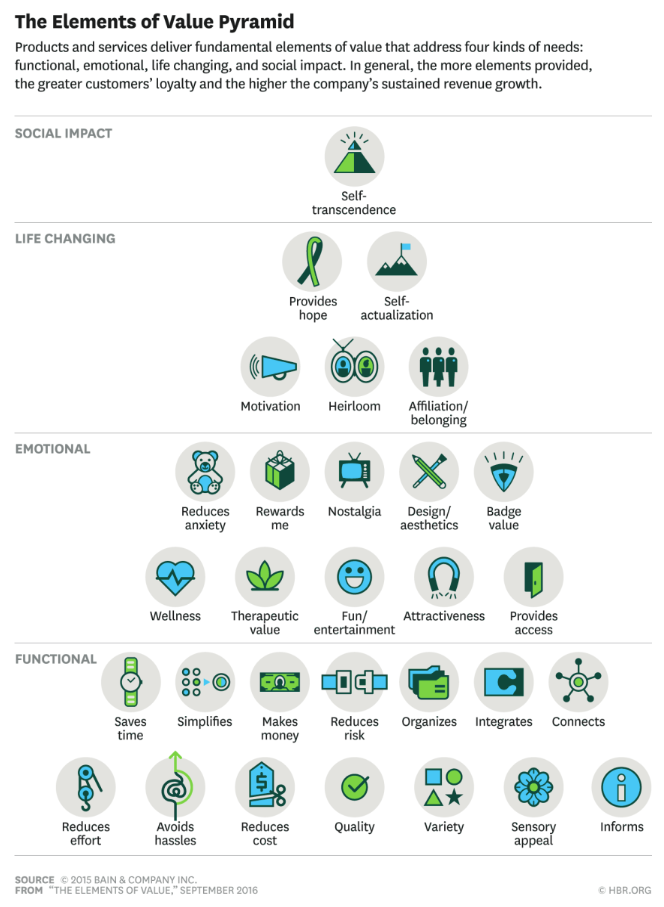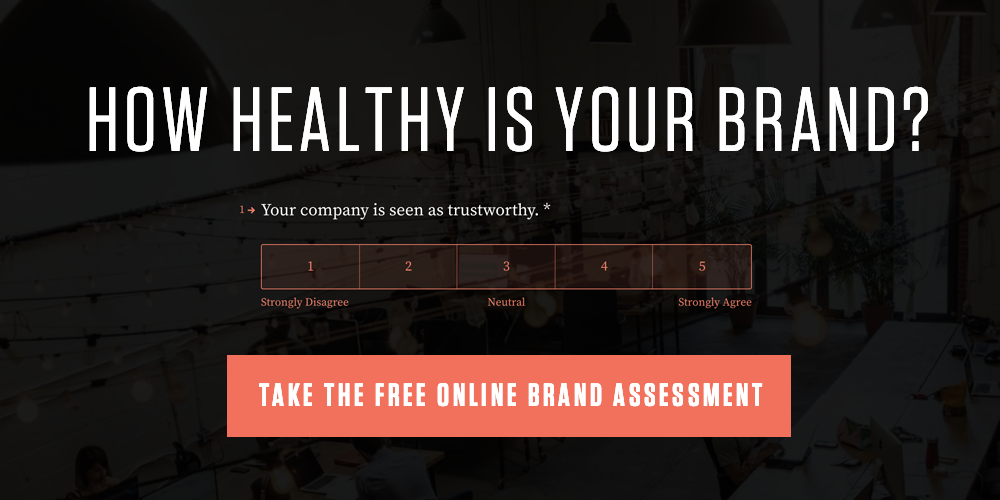Understanding the value you offer your customers is a cornerstone of successful marketing, and it's hard to pin down. There's a lot more that goes into the psychology of deciding to buy something than just weighing the price.
Marketing strategists have noticed this and noticed that it's not always easy (but always super important) to assess how your customers are perceiving value.
The Different types of Value
There are different types of value:
- There's the obvious practical or functional value that a service offers. There are also more psychological aspects of value such as how you feel about using a product, how it can make you feel accomplished or inspired, and if it gives you a sense of community or purpose.
- Emotional value
- Life-changing value, and
- Social impact value
The Value Pyramid
To navigate these important and diverse elements of value, the people at Harvard Business Review have come up with something called The Elements of Value Pyramid. It helps make it easier to pin down what customers are looking for when they assess the value of a good or service. Here it is:

***Note: If the pyramid and its accompanying jargon remind you a little of the Maslow's hierarchy of needs you learned about in Psych 101, it's for good reason. It was based on the hierarchy of needs format and carries some of the same themes: for example, you'll notice that self-actualization, an idea coined by Maslow, is actually an element within the pyramid. Also, this pyramid follows the same heuristic theme as Maslow's, meaning you need to fulfill the basics (things at the bottom of the pyramid) before you can aim for higher level elemens. We'll dive into that soon.
How To Read It
Looking at the pyramid bottom to top, you'll see thirty elements that marketers have honed in on as the main ways customers derive value from a good or service. These value elements work as building blocks and can be combined for any service.
For example, a cell phone company could desire to cover the following elements: reduces risk, quality, reduces cost, informs, sensory appeal, connects, integrates, and on and on all the way up to affiliation/belonging which is part of the "life changing" section in the pyramid. (As soon as a cell phone company comes along that does this, let me know.)
So, if these elements pre-exist in the minds and motivations of a customer, then identifying and coming up with the right combination of building blocks is the job of a business. If a business succeeds at combining the right building blocks of value, they reap the benefits of stronger customer loyalty, greater consumer willingness to try a particular brand, and sustained revenue growth. There's a lot of motivation for figuring out the value you provide.
Not All Elements Are Created Equal
Depending on what industry you're in, some of these elements will be more important than others. As mentioned above, it's nearly impossible to succeed as a company if you provide emotional or life-changing value, but offer absolutely zero functional value. A product or service needs to offer at least a couple of foundation functional value elements to have the legitimacy to even try moving up the pyramid to the higher level ones. And as you can imagine, the most important functional value element across industries is quality. If you don't have a quality product, none of the other value elements will matter much.

All four kinds of elements are important, however. Having functional elements is a necessity, but without emotional value elements, you may lose your customers to competitors that give them the feeling of comfort and wellness they need to feel comfortable purchasing.

If you don't offer life-changing value elements, you risk being left by the wayside when customers need to make budgeting decisions and let go of less important things (like your non-life-changing service).

Having lots of elements helps customer loyalty and revenue growth–Apple, for example, covers 11 out of the 30 elements, and companies that cover four or more elements have 20 times the NPS (Net Promoter Score–a widely used metric for customer loyalty and advocacy) as those that cover none. Seriously though, if Apple, in all its glory, only achieves 11 out of all 30, it’s not something that comes easily. You need to strategically choose which elements to focus on and which ones to leave behind.
Using the Value Pyramid as a Business
Elements can offer a lot of insight into how to navigate the industry, but if they aren't solving your business problems (AKA growing revenue) they aren't really helping you. When using the value pyramid to grow revenue, the first step is assessing what elements are most important in your industry and with your existing products and services.
If you are a bank, and you aren't a master at reducing effort and saving time (functional value elements), then your first step is to improve on those basic elements related to your industry so that you don't lose customers to the competition. If you've got all the basic elements down that your company should realistically already offer, you can also use the value pyramid as a list of new value elements you could try implementing. When Amazon was already rocking at providing goods and services, they decided to implement an entertainment element through TV and movies, and this skyrocketed their sustained revenue growth.
In short, the value pyramid helps you to do it better than the competition and then, once you've mastered that, it helps you to do it differently than the competition. When it comes to deciding what new elements to implement or strengthen your company, you're kind of on your own.
As we mentioned, quality is always an important one, but to figure out which specific building blocks of value will lead your unique company to success, you must put in the research required, and that means talking to customers. NPS surveys and other customer feedback efforts that gather both qualitative and quantitative data is the best way for you to really foster in on which elements you need to improve upon, which ones are the most important to your customers, and which new elements could be fun and worthwhile to invest in.
The bottom line
We always have room for improvement.
–––––
How healthy is your brand? Take this free 20-question survey to find out.



